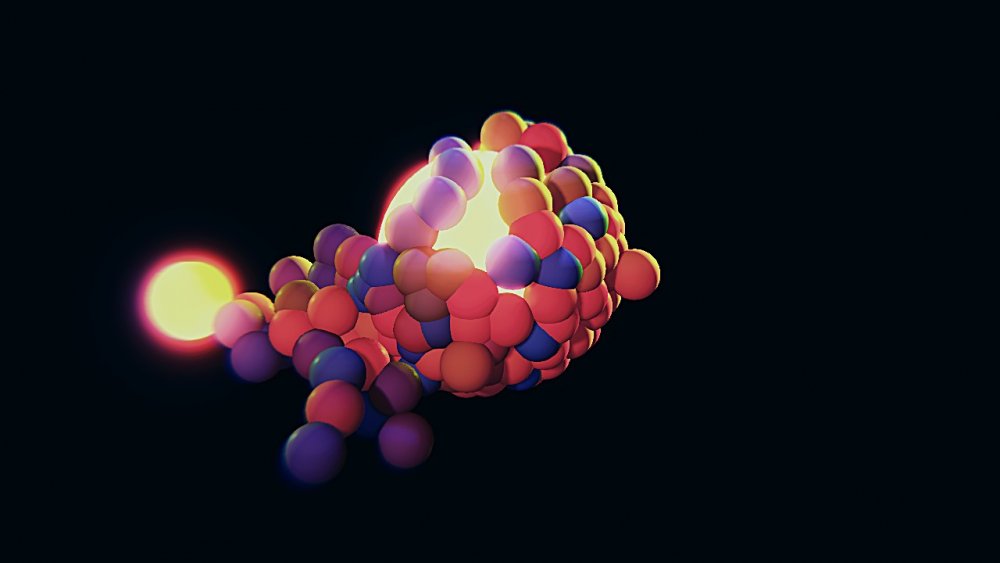Clone To Particles
Generates Clones from an input Particle system



This node creates clones at positions defined by a particle system. A Particle Root Node or a Particle Emitter must be connected to the Particle Node input for this node to be operational. If a Particle Emitter is connected, then only particles emitted from this emitter are used to generate clones. If a Particle Root Node is connected, all particles under that root node may be used to generate clones.
In order to make the effect visually consistent, clones are attached to individual active particles and flow its transforms until the particle dies.
Nodes that are to be cloned should be connected to the output of this node. Any geometry node including 3D Objects, 3D Primitives, and Image Planes may be connected, as well as other Cloner systems.
These properties control the 3D transforms of the node. Transforms will generally be inherited by child nodes, although they can be ignored through the Inherit Transform Channels attributes.
| Parameter | Details |
|---|---|
| Position X | Move along the local x-axis. |
| Position Y | Move along the local y-axis. |
| Position Z | Move along the local z-axis. |
| Rotation Heading | Rotate around the local y-axis. |
| Rotation Pitch | Rotate around the local x-axis. |
| Rotation Bank | Rotate around the local z-axis. |
| Scale X | Scale along the local x-axis. |
| Scale Y | Scale along the local y-axis. |
| Scale Z | Scale along the local z-axis. |
Control the inheritance of the transforms from the parent.
| Parameter | Details |
|---|---|
| Position | Toggle inheritance of the Position from the parent. |
| Rotation | Toggle inheritance of the Rotation from the parent. |
| Scale | Toggle inheritance of the Scale from the parent. |
| World Position Only | Inherit the world position from the parent only, rotation and scale will be ignored. Overrides above properties. |
| Inherit Time | Toggle inheritance of time from the parent. |
These properties control the core behaviours of the node.
| Parameter | Details |
|---|---|
| Node Spawn Mode | Change the order in which the cloned objects are assigned to clone instances.
|
| Num Clones | Number of copies of the input object created by the node. |
| Rotation Affects Clones | The rotation of the source particles affects the cloned objects. |
| Scale Affects Clones | The scale of the source particles affects the cloned objects. |
| Colour Clones | The colour of the source particles is copied to the cloned objects. |
| Clone Scale | Scale the size of all the clones uniformally. |
| Size Randomness | Add randomness to the size of the objects. |
| Luminance Randomness | Randomises the luminance values of the clones based on the particle colours. Only functions when “Colour Clones” is enabled. |
| Rotation Stiffness | How much clones resist rotating. |
| Rotation Mode | Change how the clones are rotated based on their source particles.
|
| Rotation Rate | How quickly the clones rotate in spin mode |
| Rotation Rate Randomness | Randomness applied on top of the rotation rate per clone. |
| Scale Stiffness | How much the clones resist scaling. |
| Particle Min Age | Minimum age a particle must have to generate a clone. |
| Particle Max Age | Maximum age a particle must have to generate a clone. |
These properties apply iterative offsets to the UV Offset, UV Scale, and Crop parameters of the materials for each rendered clone. Typically used with a tile sheet so that each clone picks up a different texture.
| Parameter | Details |
|---|---|
| UV Mode | Change how the cloned objects UV chanel and material inputs are affected by the cloner.
|
| Texture Num Frames X | How many columns to split the UV by. |
| Texture Num Frames Y | How many rows to split the UV by. |
| UV Scale X Delta | Relative change to the uv scale along the x of the clone’s material, per clone. |
| UV Scale Y Delta | Relative change to the uv scale along the y of the clone’s material, per clone. |
| UV Offset X Delta | Relative change to the uv offset along the x axis of the clone’s material, per clone. |
| UV Offset Y Delta | Relative change to the uv offset along the y axis of the clone’s material, per clone. |
| Crop Left Delta | Relative change to the crop on the left of the clone’s uvs, per clone. |
| Crop Right Delta | Relative change to the crop on the right of the clone’s uvs, per clone. |
| Crop Top Delta | Relative change to the crop on the top of the clone’s uvs, per clone. |
| Crop Bottom Delta | Relative change to the crop on the bottom of the clone’s uvs, per clone. |
| Name | Description | Typical Input |
|---|---|---|
| Particle Node | Source particles to generate clones from. A particle must be connected for the cloner to generate clones. | Particle Root |
| Effectors | Control how the clones behave once spawned. See Effectors. | Plain Effector |
| Transform Modifiers | Apply the transforms of another node to this node. | Null |
| Target Node | Modifiy the rotations of the node to always direct the z axis towards the input. | Null |
| Local Transform Override | Apply the transforms of another node to this node, relative to its parent. | Null |